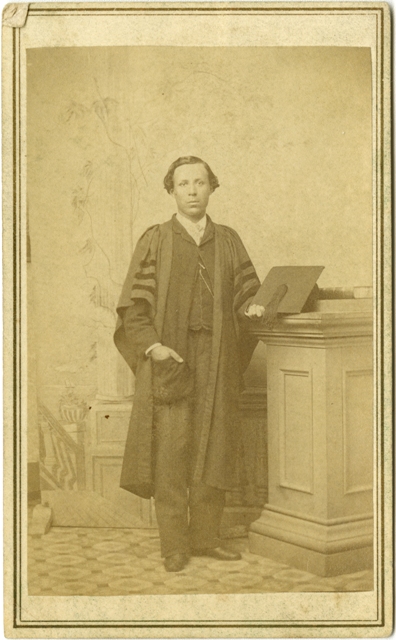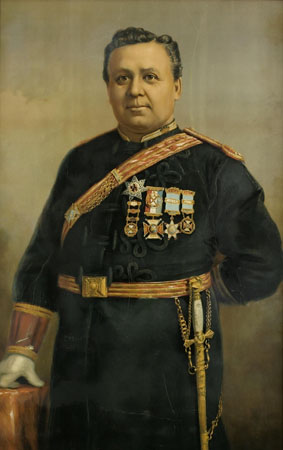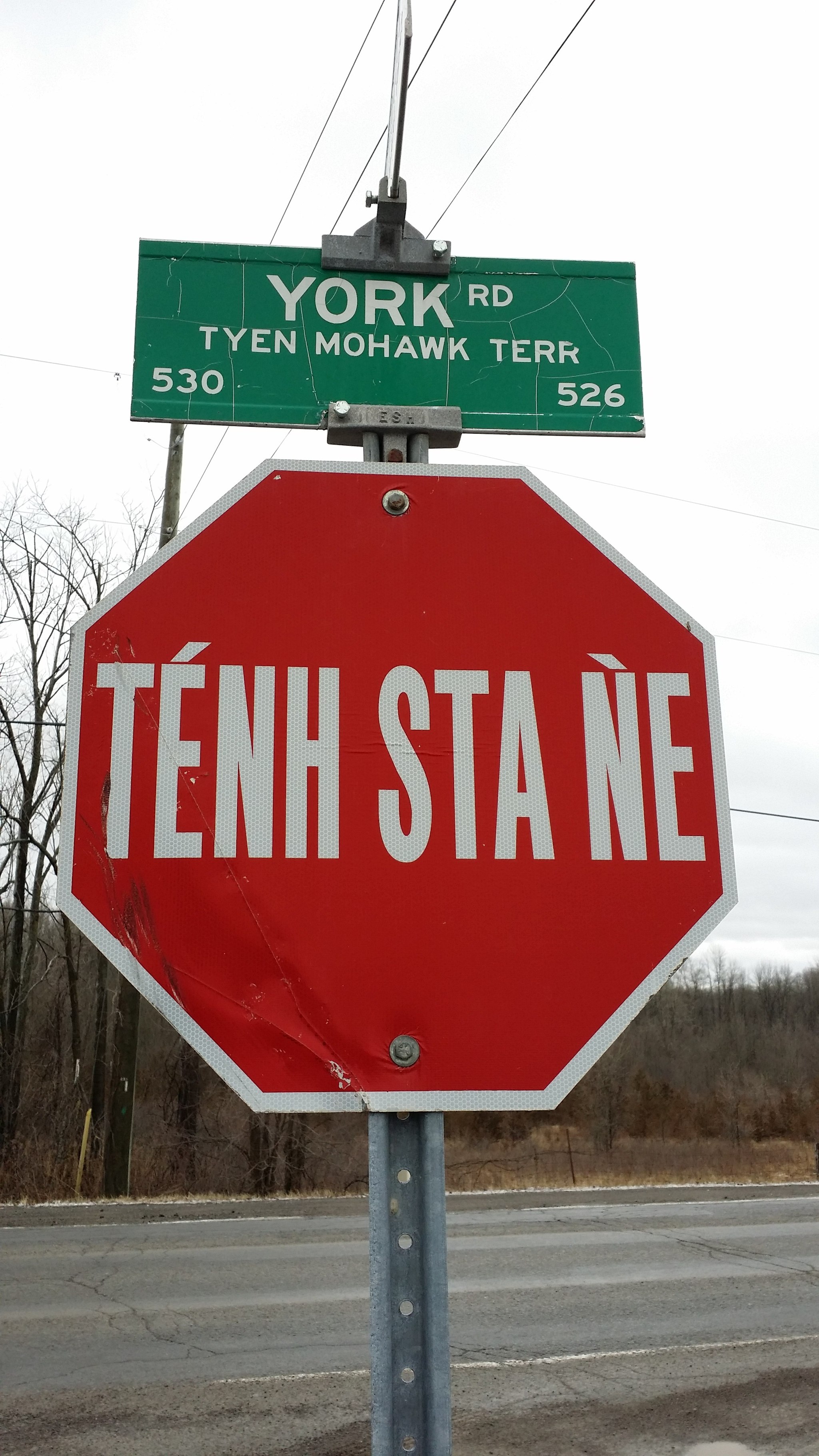Oronhyatekha (pronounced O-RON-ya-day-ga, meaning "Burning Sky" or “Burning Cloud”), also known as Peter Martin, a Kanyen'kehà:ka (Mohawk) medical doctor and businessman (born 10 August 1841 on the Six Nations of the Grand River reserve near Brantford, Canada West [now Ontario]; died 3 March 1907 in Savannah, Georgia, US). In 1867, Oronhyatekha became the second Indigenous person in Canada to earn a medical degree. Passionate about Indigenous issues, he was elected to the Grand General Indian Council of Ontario and Quebec in 1872, where he fought against the restrictive measures of the Indian Act. Oronhyatekha was also a businessman and, in 1881, headed the Independent Order of Foresters.
Early Life
Oronhyatekha was the sixth son of Lydia Loft and Peter Martin senior. The number of his siblings is unclear, but he had perhaps up to 17 brothers and sisters. His third cousin was the famed poet and performer, E. Pauline Johnson.
Education
As a child, Oronhyatekha attended the Martin’s Corner school and later, the Mohawk Institute, a residential school where he trained as a shoemaker. The New England Company (NEC), the missionary arm of the Anglican Church, ran both schools. From 1854 to 1856, Oronhyatekha attended Wesleyan Academy in Wilbraham, Massachusetts, before returning to the Grand River to teach. In 1857, he studied at Milnor Hall, the preparatory school for Kenyon College in Ohio, and then enrolled at Kenyon the following year. Money was an issue; the NEC partially funded his education, but Oronhyatekha had to leave Kenyon after only two years of college. He moved back to Canada, to teach at Tyendinaga Mohawk Territory, a reserve near Belleville, Ontario.
In 1860, the Six Nations of the Grand River council asked Oronhyatekha to present a welcoming speech to the Prince of Wales, who was touring Canada that year. Henry Acland, the prince’s personal physician, befriended the young Oronhyatekha. Both interested in medicine, Acland suggested that he attend Oxford University in England, where Acland taught. In 1862, Oronhyatekha enrolled at Oxford, but the NEC missionary at the Grand River opposed his studies. Oronhyatekha returned to his teaching position at Tyendinaga after only a few months.
In 1863, he entered the Bachelor of Medicine program at the Toronto School of Medicine (TSM), partially funded by the NEC. In 1866, he enrolled in the TSM Doctor of Medicine degree, graduating in 1867 as the second Indigenous person to earn a medical degree in Canada.
Queen’s Own Rifles
While a student in Toronto, he joined the University Rifles, Company 9 of the Queen’s Own Rifles (QOR), a militia unit. Company 9 fought at the Battle of Ridgeway in the 1866 Fenian Raids during which Irish-American insurgents invaded Canada from the United States. As a member of the QOR, Oronhyatekha competed in numerous rifle-shooting competitions, a popular pastime, and in 1871, won numerous awards at the Wimbledon match in England as part of the first Canadian national team.
Family
In 1863, Oronhyatekha married Ellen Hill (1843–1901) of Tyendinaga, whom he had met while teaching. They had six children: Catherine Evangeline Karakwineh (1864–1939), William Acland Heywood (1869–1907), Henry Wentworth Herbert (1871–81), Albert Edward (1873), Annie Edith (1874–76), and John Alexander Herbert (1882–84).
Medical Career
Dr. Oronhyatekha practised medicine first in Frankford (near Belleville), then in Stratford, Napanee, Buffalo (New York), London, and finally, Toronto. While in Napanee, the Department of Indian Affairs (DIA) appointed him as the physician to Tyendinaga. After he moved to London, the DIA appointed Dr. Oronhyatekha as physician to the Oneida of the Thames reserve.
Independent Order of Foresters
In 1878, Dr. Oronhyatekha joined a London branch of the Independent Order of Foresters (IOF), an international fraternal organization that offered insurance to its members. He moved swiftly up the ranks, until he became its Supreme Chief Ranger in 1881. In 1889, Dr. Oronhyatekha moved the IOF from London to Toronto and built a new headquarters, the Temple building. When it opened in 1897, the Temple stood 10 storeys high with an additional two-storey central tower; it was the tallest structure in the British Empire at its time.
He established the Oronhyatekha Historical Rooms and Library at the Temple in 1902. The over 2,000 artifacts included natural history specimens, cultural objects from around the world, Indigenous-made items, and pieces related to the development of the IOF. Dr. Oronhyatekha also wrote the History of the Independent Order of Foresters (1894).
His wife’s family owned Captain John’s Island off the shores of Tyendinaga. In the 1890s, Dr. Oronhyatekha renamed it Foresters’ Island. Here, he constructed two homes known as the “Wigwam” and “Sherwood Forest Castle,” as well as cottages, a hotel, dining hall, bandstand, and a wharf. As the IOF expanded, the organization extended its insurance benefits to the young and the old. In 1903, Dr. Oronhyatekha began building an orphanage on the island for children of deceased IOF members, and he intended the Castle to be a seniors’ home for retired members.
Dr. Oronhyatekha transformed the IOF from a bankrupt organization of fewer than 400 members, to a membership of more than 250,000, and an insurance fund of over $10 million. He also established the Foresters in the United Kingdom, Europe, Australia and India. His success was challenged by the 1906–07 Royal Commission on Life Insurance, which examined the practices of both commercial and fraternal insurance organizations in Canada. The commissioners concluded that fraternal insurance companies charged insufficient fees to be able to meet their claims as members retired or died, and drafted a new insurance act to regulate the industry.
Activism and Community Work
Dr. Oronhyatekha joined many fraternal bodies, including the Orange Order, the Masons, and the Independent Order of Good Templars of which he ultimately became the Right Worthy Grand Templar, the head of the organization, in 1891.
He was a strong temperance advocate. He joined the American National Temperance Society and the Canada Temperance Union, and lobbied for the prohibition of alcohol.
The Grand General Indian Council of Ontario and Quebec elected Dr. Oronhyatekha its chairman in 1872. This group protested the increasingly restrictive Indian Act, which governed Indigenous peoples in Canada. In 1885, he lobbied for support for the Electoral Franchise Act proposed by Prime Minister John A. Macdonald, which would give some Indigenous peoples the vote. (See also Indigenous Suffrage.)
A believer in gender equality, as the IOF Supreme Chief Ranger, Dr. Oronhyatekha extended membership to women despite strong internal opposition.
Death
Dr. Oronhyatekha was unwell during the 1906–07 Royal Commission on Life Insurance hearings; he had long suffered from the complications of diabetes. Shortly after his testimony concluded, he travelled to Savannah, Georgia, to rest, but died of a heart attack on 3 March 1907. After his death, Dr. Oronhyatekha lay in state at Massey Hall in Toronto, where about 10,000 people paid their respects.
Legacy
Dr. Oronhyatekha’s life and work has been commemorated by a variety of public institutions and organizations. In 1957, the Ontario Archaeological and Historic Sites Board (now Ontario Heritage Trust) erected a plaque near the Oronhyatekha family gravesite in Tyendinaga. Nearby stands another plaque, this one mounted by the Historic Sites and Monuments Board of Canada (HSMBC) in 2005. The HSMBC also declared Dr. Oronhyatekha a person of national historic significance. The Toronto Historical Board (now Heritage Toronto) honoured Dr. Oronhyatekha with a plaque in Allan Gardens in 1995.
The IOF museum artifacts now reside at the Foresters Financial company headquarters in Toronto, and at the Royal Ontario Museum (ROM), which accepted part of the collection
in 1911. In 2001, the ROM and Woodland Cultural Centre launched a major exhibit about Dr. Oronhyatekha, called Mohawk Ideals, Victorian Values: Oronhyatekha, M.D.
Meet Dr. Oronhyatekha, or Burning Cloud as he was known in Mohawk. Oronhyatekha grew up on Six Nations reserve and attended residential school where he trained to be a cobbler - but life had bigger plans. Hear how he became one of the first Indigenous doctors in Canada.
Note: The Secret Life of Canada is hosted and written by Falen Johnson and Leah Simone Bowen and is a CBC original podcast independent of The Canadian Encyclopedia.

 Share on Facebook
Share on Facebook Share on X
Share on X Share by Email
Share by Email Share on Google Classroom
Share on Google Classroom










